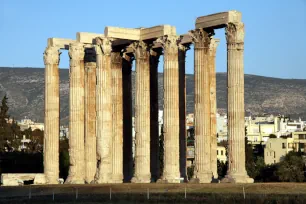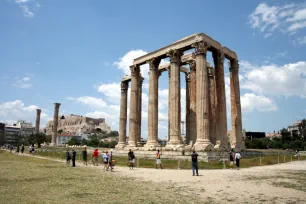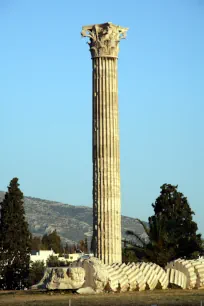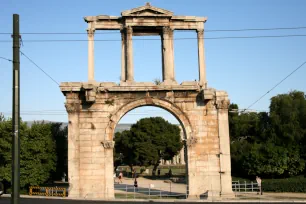The Temple of the Olympian Zeus, also known as the Temple of Zeus Olympios or the Olympieion, was the largest temple in Greece. It took almost seven centuries to complete the massive temple.

Construction of the Temple of Zeus Olympios started in the sixth century BC during the Archaic era and the temple was finally completed in the second century AD, during the Roman era.
Building the Temple


Begun in 515 BC by order of the tyrant Peisistratos, work on the temple ceased just five years later when the tyrant’s son was overthrown. During the democratic period that followed, the temple was seen as a symbol of oppression, and work was aborted.
Nonetheless, work on the temple recommenced in 175 BC, when King Antiochus IV Epiphanes reigned. He hired Roman architect Cossutius to create a design for the largest temple in the world. Unfortunately, Antiochus died in 164 BC and work ceased once more.
In 132 AD, on his second visit to Athens, the Philhellenic emperor Hadrian decided to complete the temple and dedicate it to Zeus Olympios. The temple was meant to become the center of a new district named Hadrianopolis.

The Architecture
The Temple of the Olympian Zeus was the largest in Ancient Greece, even larger than the Parthenon. It was originally conceived as a temple of Doric Order, with a planned two rows of eight columns wide and two rows with twenty-one columns in the length.
Cossutius significantly altered the original design. He added Corinthian capitals and planned three rows of eight columns at the fronts of the temple and two rows of twenty-one columns in the length. Hadrian mostly followed this design.
Today only fifteen of the 104 massive, 17.25 meters high columns (57 ft), remain standing. A sixteenth was blown over by a fierce windstorm in 1852 and was left where it fell. The columns, of Pentelic marble, have a diameter of two meters. The columns surrounded a cella (inner chamber) in which two large statues were placed: one chryselephantine (ivory and gold) statue of Zeus – a replica of the statue of Zeus that the famous Greek sculptor Pheidias created at Olympia – and a statue of Emperor Hadrian. Both statues no longer remain.
Arch of Hadrian

In 131 AD, the Athenians erected a gated archway to honor emperor Hadrian. The arch, eighteen meters tall, sits just northwest of the temple and is inscribed with two sentences. The side facing the Acropolis says “This is Athens, the ancient city of Theseus.” The other side, facing the temple and the extension of the city by Hadrian, reads “This is the city of Hadrian and not of Theseus.” The inscriptions refer to the founders of the new and the old city: the gate separated the old city (founded by the mythical hero Theseus) from the new city, Hadrianopolis, founded by the Roman Emperor Hadrian.
More buildings
Several more buildings have been discovered during the excavations around the Olympieion, including a Roman bath from around 130 AD and several temples from the same period.
- Next: Roman Agora
- More Sights & Attractions in Athens

